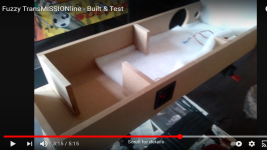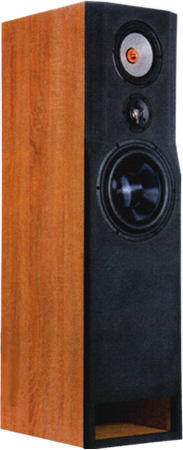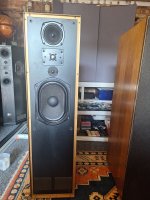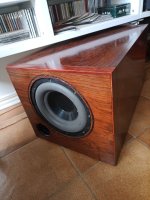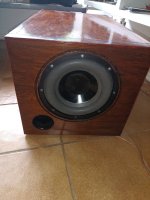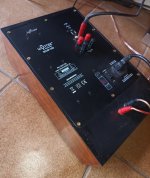Fuzzy TLAt the cover PDF of that magazine you see the internals of this "fuzzy" line. It is very simple to build, using only straight cuts and takes care of unwanted resonances. Quite large too and very capable with the 10" woofer.
Just to show the huge contrast to the old "Bailey style" transmission line constructions, that had quite some problems.
| - Tweeter Seas TWS 27-6 (without ferrofluid) - Bass driver Mission CP 168 |
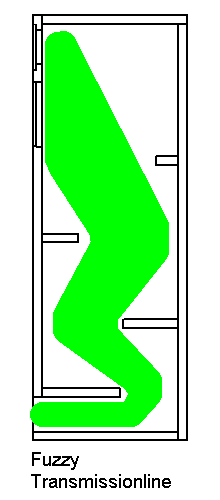
Peerless 830657 Qts .46, Vas 31 litres, fs 45 hz possible substitute
vs Mission CP 168 Qts .4, Vas 27 litres, fs 44 hz
https://www.lautsprechershop.de/chassis/main_en.htm
Attachments
Last edited:
I wanted to show the thread starter a modern TML with a rather large driver, that performs like the KEF B139 (or better).
So with the TIW250 or a compareable driver, it should do what he memorizes and a little bit more. Memories often get more impressive over the years... The usual small 16cm driver sure is not what he has on his mind.
The nice thing about this "Fuzzy Style", it seems to reduce the usual dips and peaks of the old, straight TML. These made complicated damping neccesary and took away a large part of the theoretical advantages.
Many of the old builds suffered of wrong placed or stuffed damping. The building instructions always closed like: "The damping show is only an example that may not perfectly work in your room. Try different ways of damping, adding or removing material to your taste." Good luck with that!
I know first hand how this sucked. The shown damping never fit the room. In most cases, to get rid of anoying resonances, they got stuffed with so much wool that nothing of the "endless deed, thundering bass" was left. I never heard a TML that meet the huge expectations the designers/ sellers description had created. I often listened to the legendary Quadral "TITAN", a 2 meter high 115kg TML monster. Even today people rave about. It was just a high-low speaker with anything missing in between. The 32cm /13" woofer had to play up to 400Hz, but the damping removed most of this region and only left some low rumble. Nothing a well working ear would ever want to hear. Anyone who had one, origional or clone, was trying to modify it somehow. A tipical TML of the time.
So with the TIW250 or a compareable driver, it should do what he memorizes and a little bit more. Memories often get more impressive over the years... The usual small 16cm driver sure is not what he has on his mind.
The nice thing about this "Fuzzy Style", it seems to reduce the usual dips and peaks of the old, straight TML. These made complicated damping neccesary and took away a large part of the theoretical advantages.
Many of the old builds suffered of wrong placed or stuffed damping. The building instructions always closed like: "The damping show is only an example that may not perfectly work in your room. Try different ways of damping, adding or removing material to your taste." Good luck with that!
I know first hand how this sucked. The shown damping never fit the room. In most cases, to get rid of anoying resonances, they got stuffed with so much wool that nothing of the "endless deed, thundering bass" was left. I never heard a TML that meet the huge expectations the designers/ sellers description had created. I often listened to the legendary Quadral "TITAN", a 2 meter high 115kg TML monster. Even today people rave about. It was just a high-low speaker with anything missing in between. The 32cm /13" woofer had to play up to 400Hz, but the damping removed most of this region and only left some low rumble. Nothing a well working ear would ever want to hear. Anyone who had one, origional or clone, was trying to modify it somehow. A tipical TML of the time.
Thank you, but this is not helpful. Yes, there are many transmission line speaker plans out there. But this is not what I am asking for.
My question remains: Does anyone here have a catalog from Accurate Sound or plans for their Model 7 loudspeakers?
A problem with the vintage TLS is that they get a big dip around 200 Hz. The HH designs reduce that by having the driver 1/5 to 1/3 from the closed end and in some cases also use a interna Helmholz resonator. An other change is that several vintage design had cornerreflectors to smooth the bends, now they are left unsmothed to facilitate the low pass effect of bends.
Below, I've reproduced a copy of an advertisement of theirs, from the January 1977 issue of Audio Amateur, page 49...
Does anyone here recognize this, or have an old catalog or plans?
Cheers,
Bruce
Can we assume there were published articles on the kit you are looking for in AA magazine of the 70's ?
If so, there is a website selling AA issues from 1970-1979.
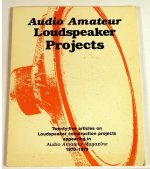
Last edited:
Dear Perry, I wanted to thank you again for your post half a year ago. You were more than correct, it turns out that Dale Pitcher was the person behind Accurate Sound and designed the speakers that I built in 1977. I'm in touch with him and hopeful that he still has copies of those fifty year old plans. Cheers, BruceI grew up in Lincoln, Nebraska and it’s almost certain that these kits were offered by a guy named Richard “Dale” Pitcher who later had a company called Essence Speakers which made transmission line speakers using typically Morel and Dynaudio drivers.
Essence Speakers was in the 80s. For a little while he had a showroom at or near that M St. address. Before that, his products were sold through a local dealer called Sound Dimensions. I also sold my own brand of speakers through that same dealer for a short time. I was 17.
Essence speakers were very good looking; idiosyncratic; had meticulous detail; sounded very good with certain kinds of music, and had a very small and devoted cult following. They had a very lean disciplined sound that was light on bass.
Apologies for not replying earlier. Unfortunately, neither Audio Amateur or Speaker Builder did an article about the Accurate Sound products. I can say this with confidence, because earlier this year I made several visits to the Technische Informationsbibliothek (TIB) in Hannover and went through all of the back issues starting in the 1970s.Can we assume there were published articles on the kit you are looking for in AA magazine of the 70's ?
If so, there is a website selling AA issues from 1970-1979.
View attachment 1414364
I'm perfectly sure there are other constructions around that could be an inspiration for you.
I just finished building a subwoofer with a basic idea from a "Hobby Hifi 6/2001" publication, as I had two matching NOS drivers.
I took the best ideas of that plan and infused 24 years of additional knowledge collected.
In fact I'm very surprised what a sub with opposing drivers and a simple 300W DSP amp can do today, giving me flat 25 Hz at my listening position. Using parts for only a little more than 150€.
I don't publish much of my builds, because of my permanent use of drivers on sale, bought at a fraction of the recommended sales prices and not available any more. As seriously I don't need any new speakers, this is how I justify buying them. So if no one can copy it, what is the use of showing them around?
Also, the speaker people like today, are so small in most cases, I would not even use them as satellites in a 2.1 system.
IMO a 70x40x40cm sub is on the small side, with 112 liters outside volume and two 10" drivers. It just disapears im my room. We used to build floorstanders that size in the days...
I just finished building a subwoofer with a basic idea from a "Hobby Hifi 6/2001" publication, as I had two matching NOS drivers.
I took the best ideas of that plan and infused 24 years of additional knowledge collected.
In fact I'm very surprised what a sub with opposing drivers and a simple 300W DSP amp can do today, giving me flat 25 Hz at my listening position. Using parts for only a little more than 150€.
I don't publish much of my builds, because of my permanent use of drivers on sale, bought at a fraction of the recommended sales prices and not available any more. As seriously I don't need any new speakers, this is how I justify buying them. So if no one can copy it, what is the use of showing them around?
Also, the speaker people like today, are so small in most cases, I would not even use them as satellites in a 2.1 system.
IMO a 70x40x40cm sub is on the small side, with 112 liters outside volume and two 10" drivers. It just disapears im my room. We used to build floorstanders that size in the days...
I'm intrigued. Just to help me understand your system better, what's the NOS driver you used? What's your "simple 300W DSP amp"? I realise that these may no longer be obtainable, but it will help me to understand what you've done.I just finished building a subwoofer with a basic idea from a "Hobby Hifi 6/2001" publication, as I had two matching NOS drivers.
I took the best ideas of that plan and infused 24 years of additional knowledge collected.
In fact I'm very surprised what a sub with opposing drivers and a simple 300W DSP amp can do today, giving me flat 25 Hz at my listening position. Using parts for only a little more than 150€.
He doesn't really know me (we met once or twice), but say hi anyway. He turned out some admirable designs.Dear Perry, I wanted to thank you again for your post half a year ago. You were more than correct, it turns out that Dale Pitcher was the person behind Accurate Sound and designed the speakers that I built in 1977. I'm in touch with him and hopeful that he still has copies of those fifty year old plans. Cheers, Bruce
I only wanted to mention that old projects, modified, can give better results than the origional plan.I'm intrigued. Just to help me understand your system better, what's the NOS driver you used? What's your "simple 300W DSP amp"? I realise that these may no longer be obtainable, but it will help me to understand what you've done.
Even as this is OT, here is what I did, using a 24 year old plan as inspiration. I used two Mivoc AXX 1010 subwoofer driver and a Wyntek WAM300 DSP plate amp. the drivers are on opposite sides of a vented 75 liters net volume cabinet. Usually a vented cabinets drop of very steep at the low end, making equalizing useless. In this case the cabinet is intentionally too large and tuned too low (25 Hz), not using a "correct" calculation. The result is a frequency response that reaches very low, but with a continuous, gentle decline, down to 25 Hz. Using the DSP you can pull this up to linear again and set a steep high pass at 20 Hz.. By using two drivers, you get enough max SPL This is a kind of tuning you can not use passive.
It is always surprising how well simulations match the result, if you use correct data.
I have a linear 25 Hz reproduction at the listening position in a quite large room. It is even giving you a funny feeling in the gut during measurements.
With music there is nothing missing, just deep bass, but with movies, the impact is quite surprising, compare to two "conventional" 10" subs.
I must admit that my listening room is quite nice from a modal perspective, as it is very irregular. Also the ceiling is 2.4m high on one side and 3.4m on the other, with 4.4m in the middle. I found no program to simulate such a room and bass has no boomy tendencies.
Here is a picture of the build, I don't like to put electronics into a subwoofer. The rosewood verneered panels I used are from more than 50 years old furniture. No tree had to die for this box.
Attachments
- Home
- Loudspeakers
- Multi-Way
- Copy of catalog / plans for a transmission line loudspeaker kit from Accurate Sound, Lincoln NE, circa 1977
